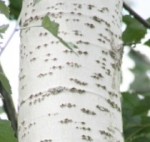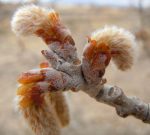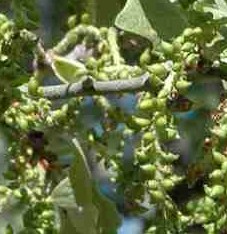 This suckering deciduous tree is native to moist areas in Europe and central Asia and is a member of the willow family (Salicaceae) that also includes aspen and cottonwood. With a wide-spreading, open canopy, the tree has grayish white bark and greenish white branches with white wooly twigs and buds. The bark darkens with maturity and becomes fissured. The leaves are toothed, have 2-3 lobes with wavy margins, and are 2-6″ long by 1.5 to 3.5″ wide. They are dark green above and covered by white wooly hairs beneath so give a shimmering effect in a breeze. In spring red male flowers and grayish green female flowers appear in catkins two to three inches long on different trees before the leaves emerge. Female flowers elongate after pollination and give way to small capsules that open in late spring to early summer and contain numerous tufted seeds. Photo Credit Wikipedia
This suckering deciduous tree is native to moist areas in Europe and central Asia and is a member of the willow family (Salicaceae) that also includes aspen and cottonwood. With a wide-spreading, open canopy, the tree has grayish white bark and greenish white branches with white wooly twigs and buds. The bark darkens with maturity and becomes fissured. The leaves are toothed, have 2-3 lobes with wavy margins, and are 2-6″ long by 1.5 to 3.5″ wide. They are dark green above and covered by white wooly hairs beneath so give a shimmering effect in a breeze. In spring red male flowers and grayish green female flowers appear in catkins two to three inches long on different trees before the leaves emerge. Female flowers elongate after pollination and give way to small capsules that open in late spring to early summer and contain numerous tufted seeds. Photo Credit Wikipedia
The Hebrew word libneh means white and is usually translated as white poplar, a common tree in wet places of Syria, Lebanon, Palestine, and Sinai. It is cultivated in the Holy Land for the dense shade it produces and historically, it provided the shade on hill top sites for the altars of the various pagan religions that have existed in the area. The branches of white poplar are long and straight and would be suitable for Jacob’s rods (see below). Some authorities, however, think that libneh refers to storax (Styrax officinalis) a short scrubby shrub with whitish leaves, white flowers, and short branches. Storax could not provide branches suitable for Jacob’s rods or good shade for an alter.
Genesis 30:37 n(NKJV) After Jacob negotiates a deal with Laban to start building a flock of sheep and goats for himself he uses rods from various trees in a breeding program to build up the strength and vitality of his stock so as to become wealthy.
“Now Jacob took for himself rods of green poplar and of the almond and chestnut trees, peeled white strips in them, and exposed the white which was in the rods.”
Hosea 4:13 (NKJV) God rebukes the people of Israel for wanting to add pagan gods into their worship.
“They offer sacrifices on the mountaintops, and burn incense on the hills, under oaks, poplars, and terebinths, because their shade is good. Therefore your daughters commit harlotry, and your brides commit adultery.”

White poplar likes full sun and average, medium moist, well-drained in USDA Hardiness Zones 3-8 but tolerates some shade, wet soils and some drought. It is susceptible to damage by leaf hoppers, thrips, borers, aphids, caterpillars, scale, dieback, canker, rust, and powdery mildew, Propagation is by very fresh seed, division of suckers, and hardwood cuttings. An adaptable tree, white popular is a good choice for such uses as erosion control and windscreens but because the roots are shallow, spreading, and invasive, they should be grown far from sewer lines, drains, sidewalks, and pavements. In addition, strong winds may topple the trees and/or break branches, and abundant seed production and suckering may allow white poplar to crowd out native species.
The genus name, Populus, is the Latin word meaning people and may refer to the use of some members of the genus in public places. The specific epithet, alba, is the Latin word meaning white and refers to the grayish white bark.
Photo Credit Matt Lavin Wikimedia Commons
